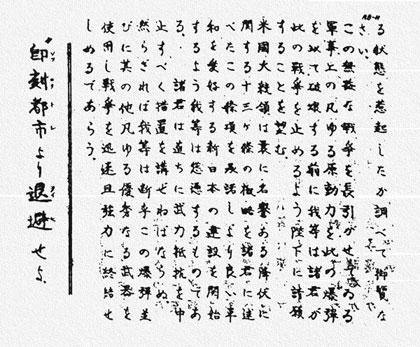The Atomic Bomb: Hiroshima and Nagasaki
Leaflet Dropped Over Japan (1945)
Annotation
Hours after the Hiroshima bombing, American bombers again took to the skies over Japan. This time their payloads contained not bombs but leaflets: printed warnings in Japanese cautioning those on the ground of the fearful new weapon the U.S. had deployed. Addressed to “The People of Japan,” it notified them that the United States possessed “the most destructive explosive ever devised by man,” a single one of which carried the equivalent of 2,000 bomb loads of explosive power. That “awful fact,” the leaflet read, “is one for you to ponder and we solemnly assure you it is grimly accurate.” The leaflet also indicated that the weapon had already been used once in Japan: “If you still have any doubt, make inquiry as to what happened to Hiroshima when just one atomic bomb fell on that city.” It closed by urging readers to demand a quick and peaceful end to hostilities lest the U.S. employ “this bomb and all our other superior weapons to promptly and forcefully end the war.”
Such warnings to civilian populations were not unusual during the World War II. Besides offering some moral cover to the attackers, warning leaflets had other, more practical value. They sowed fear and mistrust for the government on the ground, which was often seen as unable to provide basic air defense; and by encouraging citizens to flee the cities (the leaflet dropped on Japanese civilians after Hiroshima listed not just Nagasaki but a half-dozen other potential targets) they created enormous logistical and production challenges for the target nation: civilians fleeing urban areas clogged roads and were, by definition, not working in war industries.

[Leaflet Translation]
TO THE JAPANESE PEOPLE:
America asks that you take immediate heed of what we say on this leaflet. We are in possession of the most destructive explosive ever devised by man. A single one of our newly developed atomic bombs is actually the equivalent in explosive power to what 2,000 of our giant B-29's can carry on a single mission. This awful fact is one for you to ponder and we solemnly assure you it is grimly accurate. We have just begun to use this weapon against your homeland. If you still have any doubt, make inquiry as to what happened to Hiroshima when just one atomic bomb fell on that city. Before using this bomb to destroy every resource of the military by which they are prolonging this useless war, we ask that you now petition the Emperor to end the war. Our President has outlined for you the thirteen consequences of an honorable surrender: We urge that you accept these consequences and begin the work of building a new, better, and peace-loving Japan. You should take steps now to cease military resistance. Otherwise, we shall resolutely employ this bomb and all our other superior weapons to promptly and forcefully end the war.
EVACUATE YOUR CITIES
HyperWar: A Hypertext History of the Second World War. Leaflet AB-11, August 16, 1945. Accessed March 2, 2012.
